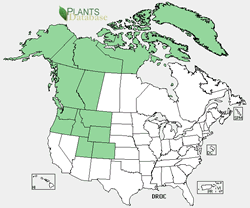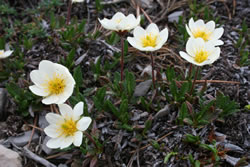Plant of the Week
 Dryas octopetala range map. USDA PLANTS Database.
Dryas octopetala range map. USDA PLANTS Database.
 Dryas octopetala in alpine meadow, Montana. Photo by Peter Lesica.
Dryas octopetala in alpine meadow, Montana. Photo by Peter Lesica.
 Closeup of the flowers of Dryas octopetala, Montana. Photo by Peter Lesica.
Closeup of the flowers of Dryas octopetala, Montana. Photo by Peter Lesica.
 Dryas octopetala in fruit. Photo by Amadej Trnkoczy.
Dryas octopetala in fruit. Photo by Amadej Trnkoczy.
 Dryas octopetala tumbling down through rock crevices in a mountain meadow. Photo by Amadej Trnkoczy.
Dryas octopetala tumbling down through rock crevices in a mountain meadow. Photo by Amadej Trnkoczy.
Mountain Avens (Dryas octopetala)
By Walter Fertig
The genus Dryas contains 2-6 species of low, mat-forming perennials in the rose family (Rosaceae). All are characterized by relatively large, white, or yellow flowers on naked stalks borne above a dense rosette of shallowly lobed leaves. In fruit, a woolly cluster of single-seeded achenes, each topped by long, silky-feathery white hairs, replaces the solitary flower. These hairs are modified from the persistent styles and help spread the attached seed via the wind. The thick tufts resemble the locks of Troll Dolls (popular in the 1960s), but apparently reminded Linnaeus more of mythological dryads or wood nymphs of ancient Latin lore when he named the genus.
Mountain avens (Dryas octopetala) is a circumpolar species found in arctic tundra of northern Eurasia and North America, but also extending southward above tree line in the Cascades and Rocky Mountains to Washington, Oregon, Utah, and Colorado. The species is morphologically variable and has been segregated into several distinct species and varieties over the years. Ecologists have also been drawn to the species because of its different growth forms associated with late snowbed sites and rocky scree slopes. Reciprocal transplant experiments have confirmed that the ecotypic variability between sites is genetically based, but sufficient gene exchange still occurs to prevent speciation.
Fossils of Dryas plants are important to paleo-ecologists studying past episodes of climate change and shifts in arctic-alpine vegetation. Late in the Pleistocene, the climate of the northern hemisphere began to gradually warm as the last great Ice Age went into retreat. On two occasions, the general pattern of warming was abruptly reversed for periods of 300-1000 years and arctic tundra vegetation returned to areas that had been changing to forest cover. Ecologists refer to these periods as the Older Dryas (approximately 13,800 years ago) and the Younger Dryas (11,500-12,800 years ago) because of the prevalence of Dryas fossils. The exact cause of the relatively rapid change in climate (estimated to have taken just a few decades) are still being debated, but may bear on research into contemporary climate change.
The flowers of Mountain avens track the movement of the sun across the sky during the day, a phenomenon called heliotropism. Most plants that have similar abilities do so to reduce the amount of solar radiation striking their flowers or leaves. In Dryas, the flowers do the opposite, moving to maximize the amount of sunlight reflecting off the petals and onto the mass of pistils at the center of the flower. Experiments by researchers in Sweden have shown that flowers that track the sun are warmer and have pistils that develop faster and produce heavier seeds than those that are shaded, have their petals removed, or are otherwise manipulated to prevent heliotropism.

